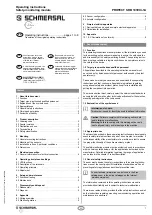
4
Operating instructions
Safety-monitoring module
PROTECT SRB 101EXi-1A
EN
The electrical connection may only be carried out by autho-
rised personnel in a de-energised condition.
Wiring examples: see appendix
5 Operating principle and settings
5.1 LED functions
• K1: Status channel 1
• K2: Status channel 2
• U
B
: Status operating voltage (LED is on, when the operating voltage
on the terminals A1-A2 is ON)
• U
i
: Status internal operating voltage (LED is on, when the operating
voltage on the terminals A1-A2 is ON and the fuse F2 has not been
triggered)
• U
i
: Status internal operating voltage (LED is on, when the operating
voltage on the terminals A1-A2 is ON and the fuse F1 has not been
triggered)
5.2 Description of the terminals
Voltages:
A1
A2
+24 VDC
0 VDC
Inputs:
S11-S12
S21-S22
S21-S22
Input channel 1 (+)
Input channel 2 (+)
Input channel 2 (–)
(with cross-wire short detection)
Outputs:
13-14
Safety release
Start:
X1-X3
21-22
Feedback circuit and external reset
Auxiliary NC contact
5.3 Operating principle
• The SRB 101EXi-1A is a dual-channel safety-monitoring module for
monitoring emergency stop command devices, guard door monitors
and magnetic safety switches.
• When the safety circuits S11-S12 and S21-S22 and the feedback
circuit X1-X3 is closed, the safety-monitoring module is started and
the enabling circuit 13-14 is closed.
• The enabling circuit 13-14 is immediately opened when the emergen-
cy stop command device or another safety equipment is operated.
• Through the signalling path 21-22 an external control of the switching
condition of the SRB 101EXi-1A can be signalled for instance.
• The safety-monitoring module can only be restarted, when both
channels K1 and K2 have been enabled.
5.4 Adjustment
Opening the front cover (see Fig. 3)
• To open the front cover, insert a slotted screwdriver in
the top and bottom cover notch and gently lift it.
• When the front cover is open, the electrostatic discharge
requirements must be respected and observed.
• After setting, the front cover must be fitted back in position.
Setting the switch (see Fig. 4)
• The cross-wire short monitoring function (factory setting) is
• programmed by means of the switch underneath the front
cover of the safety-monitoring module.
• The switch must only be operated in de-energised condition
by means of a finger or an insulated blunt tool.
• Pos. nQS (top),
not cross-wire short proof
:
suitable for 1-channel applications and applications with
outputs connected to potential in the control circuits.
• Pos. QS (bottom), cross-wire short proof:
suitable for 2-channel applications without outputs connected
to potential in the control circuits
5 cm
a)
b)
c)
d)
5 cm
5 cm
5 cm
Fig. 1
a) IP54 control box suitable for installation in Zone 2 to EN 60079-15
b) Air around the safety-monitoring module approx. 2,400 cm
3
(8.25 × 16 × 18.1 cm)
c) Contactor II 3G
d) Terminals (Kl. II 3G)
Potential equalisation: wiring of the PA terminals (Fig. 2)
According to EN 60079-14 par. 12.2.4, 2 cables with a section of
at least 1.5 mm
2
must be inserted between the PA terminals and
the potential equalisation.
U
EXi
U
B
U
i
K1
K2
SRB
101EXi
-1A
0V X1 X3
S11 S12 S21 S22
13 14 21 22
PA PA A1 A2
2 x 1,5 mm
2
Fig. 2
3.4 Dimensions
All measurements in mm.
Device dimensions (H/W/D): 100 x 22.5 x 121 mm
4 Electrical connection
4.1 General information for electrical connection
As far as the electrical safety is concerned, the protection
against unintentional contact of the connected and therefore
electrically interconnected apparatus and the insulation of the
feed cables must be designed for the highest voltage, which
can occur in the device.








